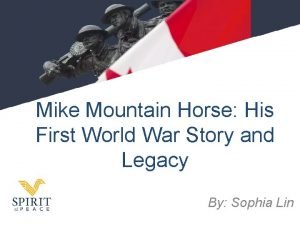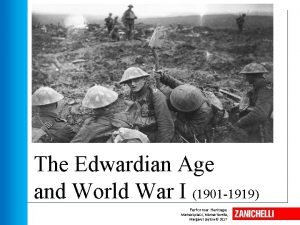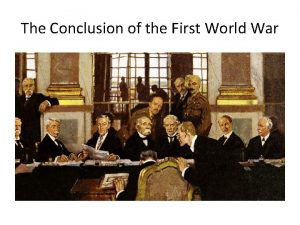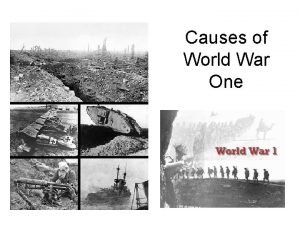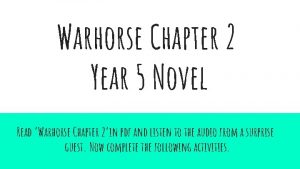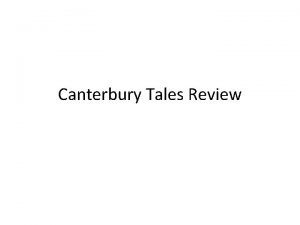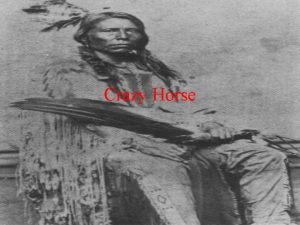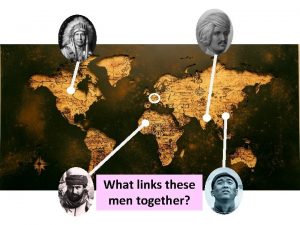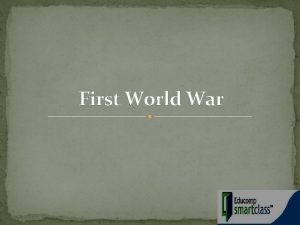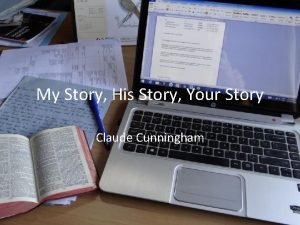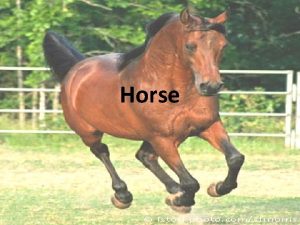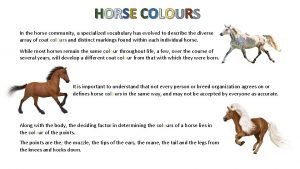Mike Mountain Horse His First World War Story












![[5] August 21, 1917 – Battle of Cambrai “M. Mountain Horse was buried in [5] August 21, 1917 – Battle of Cambrai “M. Mountain Horse was buried in](https://slidetodoc.com/presentation_image_h/3165eb7a1501986efebf16b7fd48630d/image-13.jpg)






- Slides: 19

Mike Mountain Horse: His First World War Story and Legacy By: Sophia Lin

Who was Mike Mountain Horse? An iconic and inspiring figure in his hometown of Lethbridge, and all across Canada, Mike Mountain Horse was a member of the First Nations Blood Tribe who became a World War I hero. He was born in 1888 to Mountain Horse and Sikski, then given the name Crow Flag. In 1907, when he was 19, he enlisted as a scout for the Royal North-West Mounted Police, serving in the Macleod and Lethbridge districts for nine years. Until in 1916, he decided to join the He attended St. Paul’s Residential School on the Blood Reserve, later transferring to the Calgary Indian Industrial School. During his early life, he had a natural interest in school and talent in athletics. This photo was taken when he was elected to the Blood tribal council in the late 1950 s.

Sportsmanship noun fair and generous behaviour or treatment of others. In war, to be sportsmanlike is to be fair, to fight for your country, and accept victory and defeat alike. However, the true definition of sportsmanship is not found on the battlefield, but rather the conduct and attitude off the field, in training, and in adversity. Mike Mountain Horse encountered many challenges as a First Nations soldier among predominantly British soldiers. He dealt with racial prejudice and language barriers, and helped his fellow Blood Tribe members and other Indigenous peoples. He accommodated and embraced the Western culture that he was exposed to for the first time, while remaining proud of his own unique culture, displaying his own cultural symbols and clothing, many for good luck. He certainly wore these not only for himself, but for his fellow soldiers, no doubt remembered as an inclusive and sportsmanlike figure to look up to.

In his time as a soldier, he was injured multiple times, and came home with battle scars from three separate occasions. One of which included being buried in the debris of a German cellar four days, after the machine gun squad he Mountain Horse went was leading got ambushed by through many adversities, prior to German guns. He was gravely and during his time serving as a soldier. wounded and sent to an However, he kept moving forward and never English hospital for colonial soldiers, but recovered gave up – in both a metaphorical and literal quickly. sense, he got up every time he fell down. This Perseverance began with the death of his brother, Albert, who had been gassed in battle overseas in Instead of letting 1916 and died on the way home to Canada. this weigh him down, Here, Mountain Horse remembers: Mountain Horse channelled “The spirit of revenge for my brother’s these emotions and enlisted death manifested itself strongly in me in the army, partly to avenge as I gazed down on Alberta lying in his brother’s death – to his coffin that cold wintery day make a difference, to finish what Albert started. in November 1915. ” …

He shares his thoughts during his time in the hospital healing, and demonstrates the true spirit of a warrior who never wants to go down and lives in the moment: “… Although they’ve told me that I’ve got to stay for another two months before I am again fit for active service. I hate the idea of staying here doing nothing, and offered to go with the first draft leaving for the trenches. The officer in command said he admired my pluck, but he could not take me, so I am doomed to stay in this place for some time. ”

Part of integrity is staying true to your values and Mountain Horse went beyond this, and fought for them. His merit and excellence as a soldier was recognized by a Distinguished Conduct Medal for bravery. Despite certain cultural and linguistic differences, he united with his fellow Canadians for a common purpose and led the charge as a distinguished sergeant. Integrity noun The quality of being honest and having strong moral principles; moral uprightness. Not only did he represent his people at the front lines, but when he came home a hero, he continued to express his pride in his heritage, advocate for First Nations, and spread their culture, values, and most notably, their warrior ethic. This was the warrior ethic that fuelled him in battle and part of the reason for his enlistment was to show that life on the reserve had in no way dampened the Blood tribe peoples’ and First Nations peoples’ warrior ethic and spirit. (left) Wounded soldiers at Vimy Ridge.

Resiliency In his three years of service before being demobilized in 1919, Mountain Horse endured many hardships, some of them merely surviving a battle, such as the gruelling four day long Battle of Amiens. Though he got through the this battle, Mountain Horse got wounded and took several shots from the enemy in the Battle of Passchendaele, as well as having many other close calls, for instance, he recounts: “I got a slight scratch from a Prussian Guard during an engagement in No Man’s Land; the fellow caught me with his bayonet, on the outside of my arm, but I proved superior to him, although he made it hot for me for a time. ”

In the Battle of Amiens, he had been sent by their commanding officer, along with two others, to examine the country ahead, which was quite an honour for Mountain Horse. Later, he narrowly survived a large German shell sent his way that had demolished a mountain. This battle proved to be one of the most successful for the Allies in the World War I, as they regrouped, prepared in secret, and counterattacked along the Western Front. This resulted in the Canadians advancing 13 kilometers into the German enemy lines. At the first battle of Cambrai, a battle that had notably been followed by the biggest German counter-attack since 1914, Mountain Horse suffered from shell shock for the first time. He quickly recovered, and returned for duty for the second Cambrai engagement, from which he became wounded from being buried in the wreckage of a cellar, as aforesaid. His resiliency goes beyond surviving these and getting through them, as his true resiliency was shown in getting right back up and letting nothing deter him from making a mark in the war, and now, making a mark in history.

Inspiration As his heroic acts became known across the country, Mountain Horse inspired all Canadians regardless of background, but greatly impacted and inspired the First Nations’ community to an extent far beyond. He fuelled universal feelings of inspiration from his love for his brother and stemming from his unwavering determination to avenge his death. As a First Nations individual, Blood tribe member who not only survived the war, but excelled as a soldier, he inspired his fellow First Nations people by proving they were just as capable and are true warriors like their Blood ancestors. In his pride of his own heritage and his own country, he spurred the pride in others and inspired the desire to accomplish not only for oneself, but for one’s fellow people and country. This ambition and true warrior spirit made him a role model during his time, and now for all those to come. Even still, his timeless acts of devotion, pride, and heroism continue to inspire millions today.

Teamwork Mountain Horse led other First Nations soldiers, some that enlisted with him, on the front lines and through difficult times. These included those aforementioned, such as the Battle of Passchendaele when he was forced to take refuge in German trenches. They built a team and community of sorts, as Mountain Horse recalls many experiences with them, one including when he went with his fellow Bloods to a small clearing to pray: “Some made supplication of the success of the Allies, while others prayed for a happy return to their fathers and mothers, or to their families. ”

He was chosen to act as a scout on the front lines in France, and excelled as a soldier, gaining the rank of sergeant. On multiple occasions, he recounted his leadership, either scouting ahead or leading his section into But he also exemplified the elements of teamwork that are not enemy territory. of leadership, but caring for the welfare of others. He most certainly had their backs, as many of his accomplishments and most treasured moments, as he depicted on his cowhide robe, are those that he survived with his fellow soldiers. He achieved so much with them by his side, and most certainly, it was these shared experiences and shared mutual support that kept him and his team going. Considering how his companions remembered him, and the fond memories he recounted, it becomes clear that his team admired Mountain Horse and he similarly held a reverence for them too, no doubt building a strong community of people whose bonds outlived the war and carried them through their hardships.

Experiences in the First World War. Part of the legacy that Mountain Horse left were realistic renderings of his war experiences, listed in order of importance to him. He called it The Great Deeds of Mike [ 1 ]Mountain August 21, Horse. 1917 – Battle of Cambrai “The 50 th battalion of Calgary attacked the German trenches. Corporal M. Mountain Horse led his machine gun section on an old building behind the German defense. ” Mountain Horse heard noises in a [ 4 ] August 11, 1918 – Battle of cellar and captured a German officer. Amiens “A small party of German soldiers were approached unawares and bombed out of their trench by the M. Mountain Horse section. The enemy soldiers were shot down, with only one captured. ”
![5 August 21 1917 Battle of Cambrai M Mountain Horse was buried in [5] August 21, 1917 – Battle of Cambrai “M. Mountain Horse was buried in](https://slidetodoc.com/presentation_image_h/3165eb7a1501986efebf16b7fd48630d/image-13.jpg)
[5] August 21, 1917 – Battle of Cambrai “M. Mountain Horse was buried in this old cellar four days. He had gone down the cellar to get enemy soldiers who had surrendered to the Canadians. While he was down, a German shell wrecked the roof of the cellar. M. Mountain Horse was buried beneath the wreckage and left for dead. ” [8] Date Unknown – Battle of Amiens “M. Mountain Horse and his section killed a few survivors of a German battery and marked the German artillery with the marks and designs of the Blackfoot Confederacy. ” This robe is now displayed in the Medicine Hat Museum and Art Gallery in Alberta.

Background: Who Are the Blood Tribe? Also called the Kanai Nation, they are one of three nations comprising the Blackfoot confederacy, with a 1400 square kilometers reserve 200 kilometers south of Calgary, Alberta – the biggest First Nations reserve in Canada. Their language, part of the Algonquian linguistic group. As of the 2016 census, 1000 individuals identified as having Kanai ancestry. Historically, they mostly lived in Alberta, from the Red Deer River to the Belly River, some going as far into Montana and traded with the American Fur Company. They were a bison hunting culture and had reputation for fierce warriors, with males gaining social prestige through heroic acts of war. They passed down these war stories and victories orally, in addition to stories about history, ceremonies, and various people. Pictured above are Kanai powwow dancers in Southern Alberta circa 1910.

Later Years Mountain Horse returned to his post with the Mounted Police and also worked for the CPR for some time until 1933, when he decided to turn to writing and public speech. His writing career started with writing for a local newspaper and eventually, he wrote a book. In the late 1950 s, he retired to the Blood reserve and served on tribal council. He passed away in 1964. Upon his return from the war, he was recognized as a hero across Canada, honoured by Europeans and First Nations alike. He was celebrated at grand entries, powwows, and the Blood tribe’s sacred sun dances. . The war proved that the fighting spirit of my tribe was not squelched through reservation life. When duty called, we were there, and when we were called forth to fight for the cause of civilization, our people showed all the bravery of our warriors of old.

His Legacy Mike Mountain Horse’s legacy extends further than he could have ever imagined. From a school in his hometown named after him to a tribute to him in a Hollywood film, this goes to show the acts of a Canadian and First Nations First World War hero can leave behind a legacy that continues to inspire us for generations to come. My People the Bloods In the late 1930 s, Mountain Horse wrote a book entitled Indians of the Western Plains, but it was never published in his lifetime. Later in 1979, it was published by the Glenbow Museum and sponsored by the Blood Tribal Council under the title My People the Bloods. Many of the stories and quotations here were drawn from this book, a book that tells the stories of the war and his personal experiences in his own words. In reading this, both Mountain Horse’s great nephew Dr. L. James Dempsey and Eugene Brave Rock had felt closer to him, as it provides a nearly firsthand look at the legendary figure that is Mike Mountain Horse and help many more others understand where he came from, what he went through, and the legacy

Mike Mountain Horse Elementary School In Lethbridge, Alberta, an elementary school was named after Mountain Horse in 1988. This was to commemorate his acts of bravery and the inspiration that First Nations and all Canadians alike hold towards him. Mike Mountain Horse Elementary has goal statements to provide a safe environment that fosters all types of growth for students – academic, personal, and social. They continue to celebrate First Nations culture, and spread awareness of the challenges they face and rights they have. (middle) In May this year, they celebrated their school’s 30 th anniversary with a powwow and a traditional dance performance. As well, they honoured Mike Mountain Horse’s legacy and spread awareness about Blackfoot culture and language. (bottom) Dr. L. James Dempsey, the great nephew of Mike Mountain Horse, visited the school to tell stories about

Relevance Today: The Entertainment Industry In the DC Comics superhero film Wonder Woman, Eugene Brave Rock, a Blood reserve native, played a character known as “Chief”. He joined Gal Gadot’s Wonder Woman on a secret mission that takes place during the First World War. This was not only a Hollywood film about female representation and feminism, but also represents the First Nations soldiers who served during World War I and remembers their contributions that are so often forgotten. With the blessing of director Patty Jenkins, Brave Rock decided to dig deeper about his character and his own ancestry. He studied Mike Mountain Horse and read his books and stories. After this, he decided he wanted his character to pay tribute to his own tribe’s contributions to the war, and especially honouring Mike Mountain Horse’s bravery and warrior spirit. This created a lot of meaning for both Brave Rock and the First Nations community. Brave Rock believe that this role, and his growing profile in TV and movies has inspired many young Blackfoot people to follow their dreams and be proud of their heritage. Though Mountain Horse’s story may be that of another generation, it still carries through time, in this case, even making it to the big screen to inspire millions more.

Works Cited Crighton, Gordon. “Ksiitsikominaa: The Thunder Chief Gallery: Miistatosomitai - Mike Mountain Horse. ” Virtual Museum. www. virtualmuseum. ca/sgc-cms/histoires_de_chez_nous-community_memories/pm_v 2. php? id=story_line&lg=English&fl=0&ex=00000821&sl=9281&pos=1. Web. 20 October 2018. Dempsy, Hugh A, and Michelle Filice. “Kainai (Blood). ” The Canadian Encyclopedia. www. thecanadianencyclopedia. ca/en/article/blood-kainai. 13 August 2008. Web. 20 October 2018. Dempsy, James. “Alberta History 50 th Anniversary Issue: Mike Mountain Horse. ” Alberta History. http: //mmh. lethsd. ab. ca/documents/general/Mike%20 Mountain%20 Horse% 20 Article. pdf. 2003. Web. 20 October 2018. “Land Battles - Amiens - Canada and the First World War. ” War Museum. www. warmuseum. ca/firstworldwar/history/battles-and-fighting/land-battles/ amiens/. 20 June 2008. Web. 20 October 2018. Mahjouri, Shakiel. “First Nations World War 1 Hero Helps 'Wonder Woman' Star Find His Roots. ” ET Canada. www. google. ca/amp/s/etcanada. com/news/230824/first-nations-world-war-1 -hero-helps-wonder-woman-star-find-hisroots/amp/. 4 June 2017. Web. 20 October 2018. Olafson, Karin. “An Unexpected War Hero. ” Avenue Calgary. www. avenuecalgary. com/City-Life/War-Heroes-Remembrance-Day /. 7 November 2014. Web. 20 October 2018. “The Story of Mike Mountain Horse. ” Hill 70 www. hill 70. ca/Battle-of-Hill-70/Hill-70 -Gallery/Story-Robe/The-Story-of-Mike-Mountain- Horse. aspx. Web. 20 October 2018. Volmers, Eric. “How a First Nations First World War Hero from Alberta Helped Eugene Brave Rock Find His Character in Blockbuster, Wonder Woman. ” Calgary Herald. https: //calgaryherald. com/entertainment/movies/how-a-first-nations-first-world-war-hero-from-alberta-helped-eugene-braverock-findhis-character-in-blockbuster-wonder-woman. 2 June 2017. Web. 20 October 2018. Thank you for your time and consideration!
 Mike mountain horse ww1
Mike mountain horse ww1 Scrum mountain goat
Scrum mountain goat Why was the civil war the first modern war
Why was the civil war the first modern war The claim of papal supremacy held that
The claim of papal supremacy held that A salaried worker in a guild
A salaried worker in a guild From the edwardian age to the first world war
From the edwardian age to the first world war World war 1 conclusion
World war 1 conclusion Triple alliance
Triple alliance Climax of war horse
Climax of war horse War horse youtube
War horse youtube War horse chapter 2
War horse chapter 2 _____ you see jody's new dog yesterday?
_____ you see jody's new dog yesterday? ____ judy and liz at last month's meeting?
____ judy and liz at last month's meeting? Jake hopped on his horse and trotted around the stables
Jake hopped on his horse and trotted around the stables The horse and his boy plot
The horse and his boy plot His horse was thinner than a rake
His horse was thinner than a rake Jill is climbing where does she need high friction
Jill is climbing where does she need high friction A man called horse analysis
A man called horse analysis Short story mountain
Short story mountain Story mountain
Story mountain
